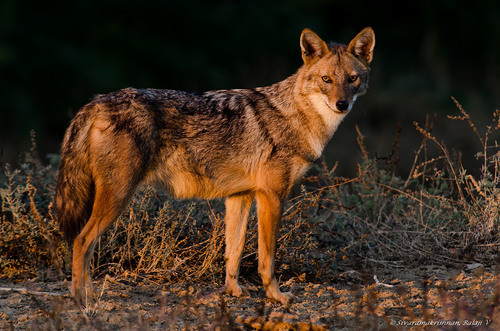Golden Jackal Did you see this animal?
Scientific Name : Canis aureus
Family : Canidae
Order : Carnivora
Class : Mammalia
Phylum : Chordata
Other Name : Jackal, Golden Jackel, Asiatic Jackal
Habitat : Forest, Savanna, Shrubland, Grassland
Description : Golden jackals have a medium-sized body, ranging from 60-90 cm in length and weighing between 6-14 kg. They have a golden brown or sandy coloration, which camouflages them well in their natural environment. They have a white belly and dark, pointed ears, which help them hear and locate prey easily. Their bushy, black-tipped tails are a distinguishing feature that helps them communicate with other members of their pack.
Golden jackals are highly adaptable and can live in a variety of habitats, including grasslands, forests, deserts, and even urban areas. They can easily adapt to human settlements and are often found scavenging around garbage dumps and urban areas for food.
These omnivores feed on a wide range of food items, including small mammals, birds, reptiles, insects, fruits, and carrion. They are opportunistic hunters and scavengers, and their diet varies depending on the availability of food in their habitat.
Golden jackals are social animals and live in family groups. They are primarily nocturnal and communicate with each other using vocalizations and body language. They have a complex social hierarchy and exhibit pack behavior, where they hunt and share food together.
Mating occurs between November and March, and after a gestation period of 60-63 days, females give birth to litters of 3-8 pups. Both parents take care of the young, and the pups stay with the family group for several months before they become independent.
Despite their adaptability and widespread distribution, golden jackals are hunted for their fur in some areas and are considered pests by some people. They play an important role in their ecosystems by regulating the populations of prey species and scavenging on carrion. Therefore, it is crucial to protect them and their habitat to ensure their survival.
Golden jackals are highly adaptable and can live in a variety of habitats, including grasslands, forests, deserts, and even urban areas. They can easily adapt to human settlements and are often found scavenging around garbage dumps and urban areas for food.
These omnivores feed on a wide range of food items, including small mammals, birds, reptiles, insects, fruits, and carrion. They are opportunistic hunters and scavengers, and their diet varies depending on the availability of food in their habitat.
Golden jackals are social animals and live in family groups. They are primarily nocturnal and communicate with each other using vocalizations and body language. They have a complex social hierarchy and exhibit pack behavior, where they hunt and share food together.
Mating occurs between November and March, and after a gestation period of 60-63 days, females give birth to litters of 3-8 pups. Both parents take care of the young, and the pups stay with the family group for several months before they become independent.
Despite their adaptability and widespread distribution, golden jackals are hunted for their fur in some areas and are considered pests by some people. They play an important role in their ecosystems by regulating the populations of prey species and scavenging on carrion. Therefore, it is crucial to protect them and their habitat to ensure their survival.
Distribution in Bangladesh
References:
description written by:Asad U. Tanvir,Department of Zoology,Jagannath University,Dhaka; reviewed by:Muntasir Akash,Department of Zoology,University of Dhaka;Taxonomic Checklist:Red List of Bangladesh Volume 2: Mammals, 2015, IUCN; information sources:wikipedia,iucnredlist.org; photo credit:pfaucher(www.inaturalist.org/people/wpfaucher), photo copyright: iNaturalist.more information please contact with us.
description written by:Asad U. Tanvir,Department of Zoology,Jagannath University,Dhaka; reviewed by:Muntasir Akash,Department of Zoology,University of Dhaka;Taxonomic Checklist:Red List of Bangladesh Volume 2: Mammals, 2015, IUCN; information sources:wikipedia,iucnredlist.org; photo credit:pfaucher(www.inaturalist.org/people/wpfaucher), photo copyright: iNaturalist.more information please contact with us.
































